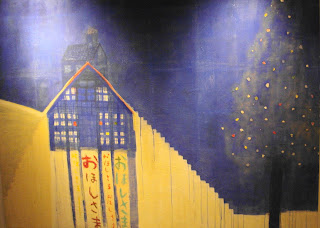August 6th November 6th 2010.
the Japan Foundation
131 Bloor Street West, Suite 213
Toronto, Ontario
 |
| The Sun” by Ryoko Aoki installation at the Japan Foundation, Toronto (photo taken with permission of Japan Foundation for fQ posting) |
 |
| detail of “The Sun” by Ryoko Aoki (photo taken with permission of Japan Foundation for fQ posting) |
According to the curator Midori Matsui, who is a Tokyo-based art critic and scholar: “Winter Garden, contains two opposing meanings: a “desolate garden in the winter time” or, idiomatically, a hothouse. This coexistence of opposite meanings embodies the central paradox of the exhibition. The first alludes to the difficulties of contemporary life brought on by globalization: worldwide economic depression, uniformity of living environments, and the disappearance of unique local cultures. On the other hand, the image of a hothouse suggests a space that, in spite of its small scale and closed artificial environment, nurtures organisms, including plants, insects, birds, and microbes- the elements that constitute rich and diverse layers of life. The exhibition attempts to explore the efforts of contemporary artists to make the most of the poverty and boredom inflicted by contemporary life in order to reorganize various aspects of their everyday activities and reinvent effective “ways of operating.”
This is what is exciting about the show “The poverty and boredom” evidenced in the apparent thrown togetherness of Ryoko Aoki piece shows in choice of materials in some cases, and the art historical references dislocated and possibly mocked or honored in other pieces like Hiroshi Sugito’s [born in Aichi, Japan 1970] “starry night” acrylic, pigment, paper mounted on panels, 182.0 X 242.o cm. Don’t be mislead by the title or the predominately blue painting, which along with two others by the same artist reference the 19th century Japanese prints that were influencing the impressionist movement in Europe after Japan was forced into trade in the 1860s. Sure “Starry Night” is a round about reference to Van Gough but its also a reclamation of “Orientalism” appropriated by European or rather “Western” Arts Academy.
 |
| Hiroshi Sugito “starry night” acrylic, pigment, paper mounted on panels, 182.0 X 242.o cm. (photo taken with permission of Japan Foundation for fQ posting) |
In “Winter Garden”there is beauty, sadness, intriguing stupidity : Koki Tanaka [born in Toichigi, Japan in 1975 ] videos “Light My Fire” 2002, Cause is Effect” 2005 and “turning the lights on” , 2007, and of course “manga”. Mahomi Kunikata [born in Kanagawa, Japan in 1979] paintings are acrylic on canvas, they are cluttered with characters and creatures from comics, cartoons “tarty Sailor Moons” and slightly insane “Pokémon” along with the landscapes they inhabit. They are like “Hello Kitty’s” toy or litter box. Actually it’s like seeing a painting of the interior of Magic Pony a store on Queen Street West in Toronto that specializes in toys, books and art inspired by Manga, anime, tattoos and things Japanese. You choose. There are artist as the curator tells us in her catalogue essay, working in a wide range of media in totally individual / idiosyncratic ways with materials ready to hand rather then the pricey materials of “Fine Art”.
.JPG) |
| Keisuke Yamamoto, "Untilted" 2006, oil and coloured pencil on paper 50.0 X 65.0 cm (photo taken with permission of Japan Foundation for fQ posting) |
But I digress. “Winter Garden: The Exploration of the Micropop Imagination in Contemporary Japanese Art” is an interesting and exciting show it captures a “zeitgeist” (I hate that word but sometimes it is appropriate) of Japan’s “Gen Y”ers who seem to be capable of more then shopping and have morphed into artist with as much style as content that are capable of unpacking nearly a century and a half of reversible/ double sided colonialism. Yet again “Hard Economic Times” has given rise to an avant-garde people by a generation of navel gazers fascinated by the mundane creating work that is anything but.
Go see this show.
“Winter Garden: The Exploration of the Micropop Imagination in Contemporary Japanese Art”
opened on August 6th and runs until November 6th 2010. at the Japan Foundation at131 Bloor Street West, Suite 213 in Toronto, Ontario. There is a free catalogue available in English and Japanese
http://www.jftor.org/index.php
Magic Pony http://www.magic-pony.com/
Great New Wave: Contemporary Art from Japan May 22 to September 7, 2008 co-presented by the Art Gallery of Hamilton and the Art Gallery of Greater Victoria Curated by Sara Knelman and Lisa Baldissera http://www.artgalleryofhamilton.com/ex_archive08.php
Canadian Artist In Japan
Jacquard 2 x 2 Montréal : Tokyo
Canadian artist, Julianna Joos, Louise Lemieux Bérubé
Japanese artists, Emiko Nakano and Mitsuko Akutsu.
September 9 – November 3, 2010
Embassy of Canada Prince Takamado Gallery
7-3-38 Akasaka, Minato-ku, Tokyo
.
 |
| Jacquard based on Mitsuko photographing her own shadow on a cobble stone street in Montreal 2008 (photo taken at Mitsuko Akutsu end of residency exhibition at the MCCT, March 11, 2009 by joe lewis |











No comments:
Post a Comment